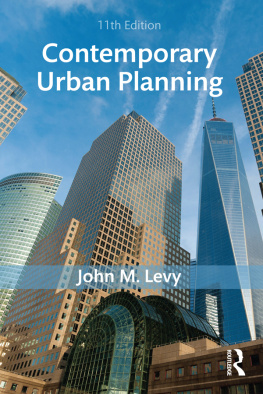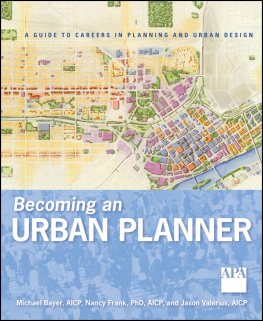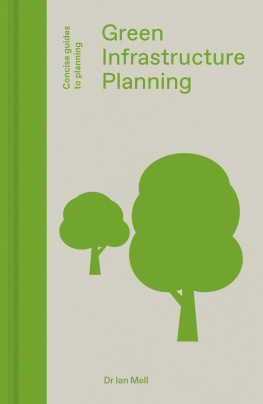First published 2017
by Routledge
711 Third Avenue, New York, NY 10017
and by Routledge
2 Park Square, Milton Park, Abingdon, Oxon OX14 4RN
Routledge is an imprint of the Taylor & Francis Group, an informa business
2017 Taylor & Francis
The right of John M. Levy to be identified as author of this work has been asserted by him in accordance with sections 77 and 78 of the Copyright, Designs and Patents Act 1988.
All rights reserved. No part of this book may be reprinted or reproduced or utilized in any form or by any electronic, mechanical, or other means, now known or hereaer invented, including photocopying and recording, or in any information storage or retrieval system, without permission in writing from the publishers.
Trademark notice: Product or corporate names may be trademarks or registered trademarks, and are used only for identification and explanation without intent to infringe.
Library of Congress Cataloging in Publication Data
Names: Levy, John M., author.
Title: Contemporary urban planning / by John M. Levy.
Description: Eleventh Edition. | New York : Routledge, 2016. |
Revised
edition of the authors Contemporary urban planning, 2013. |
Includes
bibliographical references and index.
Identifiers: LCCN 2016018104| ISBN 9781138666375 (hardback :
alk. paper) |
ISBN 9781138666382 (pbk. : alk. paper) | ISBN 9781315619408
(ebook)
Subjects: LCSH: City planningUnited States. | Urban policy
United States.
| UrbanizationUnited States. | Sociology, UrbanUnited States.
Classification: LCC HT167 .L38 2016 | DDC 307.1/2160973dc23
LC record available at https://lccn.loc.gov/2016018104
ISBN: (hbk) 978-1-138-66637-5
ISBN: (pbk) 978-1-138-66638-2
ISBN: (ebk) 978-1-315-61940-8
Typeset in Palatino
by Cenveo Publisher Servies

The term Planning is a very general one. There are city and town planners and also corporate planners. The Pentagon employs numerous military planners. The launching of a space shuttle is the culmination of a tremendously complex and sophisticated planning process. And so on.
Planning in its generic meaning, then, is a ubiquitous activity. All types of planning have a conscious effort in common to systematically improve the quality of decision making. The planning discussed in this book is a very small part of the total planning activity in the United States. Specifically, this book focuses on public planning at the substate level, that done by and for cities, counties, towns, and other units of local governments. We will also examine, much more briefly, planning for metropolitan regions, the states, and the question of national planning. One chapter contains a brief survey of planning in other nations.
The reader who has sampled other books on planning will notice that this book has some particular emphases, specifically on politics, economics, ideology, law, and the question of winners and losers in particular decisions. These emphases stem from my experience as a working planner. I entered planning in 1969 with a background in economics and journalism but with no specific training in planning. I assumed that if architects planned buildings, then city and town planners planned cities and towns in a similar way; in effect, I thought it was architecture writ large.
It did not take me long to learn that I was wrong. Planning is a highly political activity. It is immersed in politics, and inseparable from the law. The ultimate arbiter of many a planning dispute is the court. And for every case that comes to court, many planning decisions are conditioned by what the participants in the process think would be the decision if the matter did come to court.
Planning decisions often involve large sums of money, both public and private. Even when little public expenditure is involved, planning decisions can deliver large benefits to some and large losses to others. Thus one must understand something of the economic and financial issues at stake.
The study of planning quickly takes one into ideology. Planning issues and controversies inevitably raise questions about the proper role of government and the line between public needs and private rights. What properly is to be a matter of political decision, and what properly should be left to the market? Planners are a fairly idealistic lot and often enter the field to serve the public interest. After immersion in a few public controversies, the beginning planner may wonder whether there is such a thing as the public interest, for if there is, there ought to be some general agreement among the public on what it is. But one can spend a long time in some areas of planning without seeing a single instance of this agreement.
I have tried to convey something of the reality of planning practice and of what goes on under the surface of events. I hope that the reader will not find this reality disillusioning, for planning in an open and a democratic society cannot be smooth and simple. Planning as it isinvolved in political controversy, tied to legal and economic questions, and connected to issues of ideologyis far more interesting than it would be if it were simply architecture writ large.
The book contains a certain amount of material on history and technology because the issues which planning focuses on are largely ones that political, social, demographic, and economic changes bring to the forefront.
The best and most effective planners are those with good peripheral visionthose who not only have mastered the technical side of planning but also understand the relationships between planning issues and the major forces in the society around them. I have endeavored to write a text consistent with that view.
Acknowledgments
It is not possible to thank everyone who assisted in the writing of this book. However, I would like to express gratitude to my former colleagues in the Department of Urban Affairs and Planning at Virginia Tech in Blacksburg, Virginia. Various editions of this book have been reviewed by Ellen Bassett, Mirle Rabinowitz Bussell, Carissa Schively, Sheri Smith, Sujata Shetty, among others, and I am grateful to all of them.
For 10 years before I became an academic, I was employed in various capacities by the Westchester County, New York, Department of Planning, where I had the fine opportunity to learn some of the realities of planning. I am thus indebted to a number of my former colleagues there, in particular Commissioner Peter Q. Eschweiler and Planning Board Chairman the late Dr. William Cassella. When all is said and done, however, the viewpoints expressed here and any mistakes made are my own.
John M. Levy
Chapter 16
Planning for Metropolitan Regions
Most of the planning discussed in this book is that done by the individual municipality. But there are many planning issues that transcend municipal boundaries and are much better addressed at a larger-than-municipal scale. In this chapter we discuss planning at the metropolitan-area level.
The key problem in planning for a metropolitan area is the political one. By themselves, city governments are generally too small to address adequately metropolitan-area problems. Yet it is at the municipal level that much of the power and responsibility lie. The problem, then, is to set up a metropolitan area-wide mechanism that has the capacity to do effective planning. This means an organization that can obtain sufficient support and cooperation from the established institutions of government, municipal and state. This is not an easy task. Politicians, like most other people, do not readily cede power and authority to others. They need to be convinced that they and their constituents have a community of interest with the regional organization. Metropolitan planning organizations succeed only to the extent that the local and state political establishmentselected officials and their constituentssee the regional organization as useful in meeting their needs. This is necessarily so, since metropolitan-area planning takes place within the U.S. federal system, in which large amounts of authority and responsibility, such as the power to control land use, reside with local governments.











